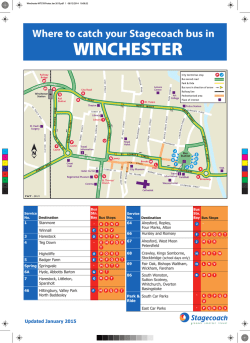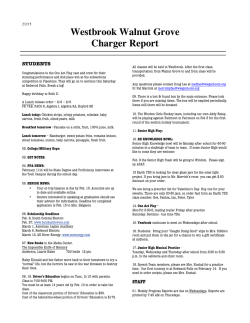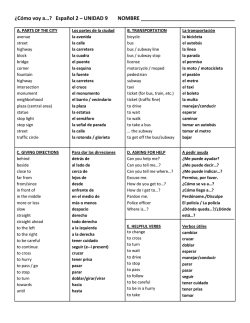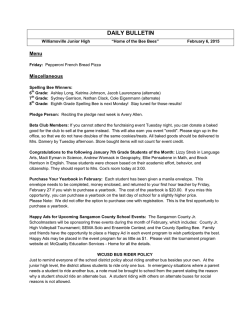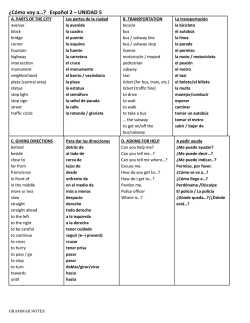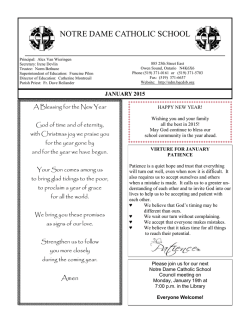
Item 11 - Transport for London
Board Date: 4 February 2015 Item 11: iBus Contract Extension This paper will be considered in public 1 Summary ID/UIPXXX iBus Contract Extension Existing Financial Authority Estimated Final Cost (EFC) £113.8m £98.2m Existing Project Authority £ N/A Additional Authority Requested £ N/A Total Procurement Authority £260.6m Authority Approval: The Board is asked to approve Procurement Authority and the extension of London Buses’ “iBus” Contract. The extension term is from May 2015 for a maximum of seven years (five years initial term with two potential one year extensions). This extension with the incumbent operator, Trapeze, will secure continuity of service while TfL commences the staged replacement of iBus. This modular strategy will allow TfL to re-tender various components of the iBus contract over the next few years to achieve better value for money, while maintaining the base of the bus and garage equipment and performance support regime with Trapeze. The new procurement strategy will introduce a multiple supplier base with the aim of establishing competition and reducing ‘lock-in’. The first stage of this strategy is to remove the radio system from the Trapeze contract and to procure this directly from the market. Financial Authority of £113.8m is contained in the 2014 TfL Business Plan to deliver the London Bus Services Ltd (LBSL) Bus Communication and Information System and Related Services (iBus), as outlined in paragraph 3.1. Additional Procurement Authority, up to a value of £98.2m, is requested to cover the up to seven year contract extension. This is a reduction of £15.6m since the original paper was submitted to the Finance and Policy Committee on 14 October 2014 and is explained in full detail at paragraph 5. This Authority is sought in addition to the original contract value of £162.4m making the new total Procurement Authority £260.6m. Outputs and Schedule: In parallel with the Procurement Authority Approval process, the existing Contract is being updated to reflect current requirements, terms and pricing, and a ”restatement agreement”, which will give effect to the contract amendments has been drafted. This restatement exercise is forecast to conclude in February 2015 and will have an effective date of 3 May 2015 (to align with expiry of the current contract). 1 1.1 Paragraph 5 refers to the detailed cost and funding breakdown for this Procurement Authority request. 1.2 At its meeting on 22 January 2015, the Finance and Policy Committee endorsed the recommendations in this paper. 1.3 A paper is included on Part 2 of the agenda, which contains exempt supplementary information. The information is exempt by virtue of paragraph 3 of Schedule 12A of the Local Government Act 1972 in that it contains information relating to the business affairs of TfL. 2 Recommendations 2.1 The Board is asked to note the paper and the supplemental information on Part 2 of the agenda and to: 2.2 (a) approve the extension of the iBus contract, as described in this paper, for a further period of up to seven years (the Extension) with a value up to £98.2m giving total procurement authority of £260.6m; (b) authorise the TfL Officers and the Subsidiaries (as described in paragraph 2.2 below) to finalise the terms of the Extension described in this paper; (c) authorise the agreement and execution (whether by deed or otherwise on behalf of TfL or any Subsidiary (as appropriate)) of any documentation to be entered into in connection with the completion and implementation of the Extension and any of the matters referred to in it (including, without limitation, all agreements, deeds, guarantees, indemnities, announcements, notices, contracts, certificates, letters or other documents); and (d) authorise TfL Officers and Subsidiaries to do all such other things as they consider necessary or desirable to facilitate the execution and implementation of the Extension and the matters referred to in it. The following Officers and Subsidiaries shall have delegated authority: (a) TfL Officers: the Commissioner, Managing Director Finance, Managing Director Surface Transport, General Counsel and Chief Finance Officer; and (b) Subsidiaries: Subsidiaries of TfL including Transport Trading Limited and any other subsidiary (whether existing presently or to be formed) of Transport Trading Limited and any directors of the relevant company shall be authorised to act for and on behalf of that company. 3 Background 3.1 In 2005, a ten year contract for the design, development, testing, installation and maintenance of a bus communication and information system, known as iBus, (the Contract) was awarded to Siemens VDO Trading Limited (Siemens) following an OJEU negotiated procedure procurement. 3.2 The Contract outsourced core technology development and associated maintenance service to Siemens. Operational management of the system and services is 2 undertaken by Technical Service Group in the Buses Directorate with commercial support from TfL Commercial. 3.3 iBus is the TfL real time bus passenger information, bus tracking and performance management system and is the data collection and calculation engine behind the £1.8bn of payments to bus operators. 3.4 In summary the iBus system supports: (a) 8,500 buses fitted with iBus equipment, running in excess of 700 bus routes and serving over 18,000 bus stops across Greater London; (b) 90 bus garages, operated by 21 bus operators, responsible for running and maintaining the bus service schedule; and (c) 42 service control centres, with work stations with the ability to track buses in real time and contact buses by voice radio. 3.5 The iBus system records mileage operated on bus routes by the bus operators on behalf of LBSL. This information is used to calculate public performance statistics and is used as the basis of mileage and reliability performance payments to the bus operators. The iBus system also calculates all of the ‘Live Bus Arrival’ predictions that are sent to the Countdown service of Web, SMS, 2500 signs and supports over 60 smartphone apps. 3.6 The Contract was novated to Trapeze ITS Switzerland GmBH Limited (‘Trapeze’) in October 2009. R TI Apps /W eb/ S MS and S igns P erformance R eporting & P ayments L ow bridge alarms R T I on the bus iB us P MR Voice R adio B us priority at s elected junctions The main functions of iBus 3 S ervice control at 42 control centres C entreC omm E mergency C ontrol C entre Basis of existing contract 3.7 The existing contract with Trapeze is a “turn-key” style contract with all elements of the service delivered by one party against a performance regime of KPIs and service credits. 3.8 TfL owns all physical assets of the system but does not own the intellectual property (IP) for any element of the system. TfL has an irrevocable licence to use and modify the IP in the system as it exists, however TfL does not have access to the source code (except under Escrow or default). TfL has ownership of the system interfaces which allows replacement of key components or component supplier should the need arise. 3.9 Under the terms of the Contract, TfL does not receive the source code on natural expiry of the contract and so would not be able to make this available to any successor contractor. 3.10 At the time of the award, it was anticipated that the assets would reach the end of their supportable life at the end of the Contract term and that the rapid advances in technology, as are typical of the industry, would have rendered the technology obsolete. In addition it was believed that business requirements would have changed to the extent that the system would no longer be fit for purpose. At the time of contract signature TfL envisaged procuring a new system(s) before the end of the ten year term. Current state 3.11 The iBus system is performing well. A system viability review was undertaken in 2013 that determined on board equipment was not obsolete and would be supportable for an additional five to seven years. 3.12 Failure rates show that the on-bus assets continue to perform to the required level (<1 per cent failure as at 1 August 2013) 1 and repairs are delivered within contractual SLAs. Equally the back office system continues to perform within its availability targets (over 99 per cent) with an excellent performance history. The Contract performance targets are linked to a service credit regime. There have been no service credit payments paid by Trapeze since December 2011. 3.13 In parallel to the proposed contract extension term, TfL will procure a next generation system to replace the core technology by 2020/21. The flexibility to go to seven years is to mitigate any potential risk of delay to the programme. Contribution to Mayoral strategy 3.14 The extension of the Contract aligns with the Mayor’s Transport Strategy and its goal to ‘support economic development and population growth’. This is achieved through meeting the strategic challenge of ‘delivering an efficient and effective transport system for people and goods’ through the following outcomes: (a) smoothing traffic flow (managing delay, improving journey time reliability and resilience); (b) improving public transport reliability; 1 A specific study undertaken in August 2013 as part of the Nimbus review. This study will be revalidated in early 2015. 4 (c) bringing and maintaining all assets to a state of good repair; and (d) providing a more efficient bus network responding to changing demand. 4 Proposal Options Considered 4.1 Do not replace, and do not extend the contract (do nothing): This option would result in a rapid degradation of service. While TfL has the right to use the software, and it is expected that the hardware would continue to operate, the contract includes service elements such as system housekeeping, repair and data integrity. Importantly, movement of buses and garage changes required to support both business as usual and the Business Plan could not be facilitated. Without these service elements it is estimated that the system would degrade and become inoperable in less than 18 months. In addition, there would be no transition to a new service provided therefore massively increasing the cost of any replacement system. NOT RECOMMENDED. 4.2 Extend the current contract for two years: This option would have no financial benefit for TfL as it is below the minimum term (five years 2) for any of the underlying contracts (i.e. communications, hosting and licencing). The estimated financial impact of this option is an increase of 25 per cent on the current five year quotation for the maintenance services. The table below shows a full NPV analysis for the two different timelines. The five year option has a net benefit to TfL as opposed to the two year option. NOT RECOMMENDED. 2 During discussion with the contractor costs were sought on a per-year basis and pursued how these could be reduced. The best deal overall was where a five-year deal was selected that showed 20 per cent discount on the per-year pricing for the subcontracts. 5 4.3 Contract the current services to a new provider: In conjunction with the TfL Commercial ICT team (the same team that advised on the procurement of Electra) an early market engagement was undertaken for Nimbus 3 (2013). This process asked questions of 37 market leaders to determine their position on “taking over and maintaining existing … system assets originally provided and supported by a different supplier”. 4.4 The suppliers that considered this option still required the on-going support of the incumbent supplier (Trapeze) for the life of the product. Therefore, any solution to contract a new supplier for the existing assets would add a layer of service provision costs in addition to the base Trapeze costs. There would be no cost saving to TfL. Overall, the responses determined that there was no appetite to this approach. 4.5 In order for a new supplier to operate the existing contract, an IP transfer would be required; the rights to which TfL does not currently hold. Trapeze confirmed in June 2013 that it was unwilling to sell or transfer the IP rights. NOT RECOMMENDED. 4.6 Move to a multi sourced platform over the next 5 years. TfL proposes moving to an open platform on bus system supported by European standards over the next five years. In order to achieve this, several new procurements will be required and the 3 Nimbus: A feasibility project describing a single on-bus technology architecture encompassing iBus and ticketing functions and associated services. This project was closed following the output of the early market engagement at Gate B with contributing input from Mott McDonald (external assurance) and IIPAG. 6 base system will need to be extended for five years with two optional one year extensions. This is RECOMMENDED. Preferred Option 4.7 The preferred option is to continue with the current iBus equipment and service through the extension of the current contract for a maximum of seven years. It is recognised that all of the equipment (on bus and back-office) will age which may eventually lead to reliability and support issues, however the on-board equipment is in good order with no sign of systemic failure. The iBus back office system was refreshed in 2013 and has a forecast life expectancy of at least five years with a forward upgrade path already defined. 4.8 During the extension period, the overall replacement strategy will commence with the re-procurement of the iBus radio, network and data/reporting as outlined in the timetable published in the table below. This table illustrates the costs that will be removed from the Trapeze Contract over the term of the extension; a total of £15.6m. Importantly these re-procurements will be undertaken in conjunction with other TfL departments, for example TfL is already looking at a combined strategy for private mobile radio (PMR) with LU and Trams. Procurement authority for these items will be sought separately. 4.9 The procurement for the multi-sourced platform and back-office components of the ‘replacement’ iBus will commence in 2016/17, with a view to complete rollout in 2021. Exit strategy, legacy considerations and risk mitigations 4.10 The discussion with Trapeze has included options for early exit for component parts of the Contract, as well as early termination for the entire Contract. The Contract contains the right to novate all subcontracts (e.g. communications and radio) back to TfL. This enables TfL to capitalise on potential savings through consolidation of such services with other TfL contracts as appropriate. 4.11 The exit strategy for the service is pre-defined and reviewed annually in accordance with the Contract. It enables transfer of any residual components at the end of the contract to a new provider if required. 4.12 As covered in paragraph 4.14, the risk of the age of equipment has been considered and this has resulted in a costed mitigation line ‘operational risk’ as per the table in 5.2. 4.13 As part of the discussion with Trapeze, TfL has included a number of additional benefits to the Contract: 7 (a) the base number of buses on the Contract has increased from 8,500 to 9,250 to align with the predicted number of additional buses required to provide transport for London's projected population growth; (b) the ability to terminate services such the PMR under the Contract, which would allow other providers to take over elements of the current end to end system; (c) an extensive revision to the Price Book (the pricing schedule for individual consumables) within the Contract through a benchmarking exercise. For example, the price for Traffic Light Pre-emption equipment has been reduced by 50 per cent; and (d) concessions of software and services. There are four detailed work package items including two design studies and an option for new on bus equipment that equates to a value of £1.2m. Risks to Preferred Option 4.14 The main risk associated with an extension of the current Contract is the age of the equipment; both back office and on bus. The Nimbus study determined that the equipment would continue to be supportable. There is also an upgrade option of the system that can be invoked if required. Legal implications 4.15 Given the constraints on TfL’s ability to share Trapeze’s IP in the design and operation of iBus, it is not possible for TfL to hold a competition to secure an alternative provider for the proposed extension period. Having taken legal advice, TfL is satisfied that it can apply an exemption under the Public Contracts Regulations 2006 from the requirement for competition for the extension period. While it is always possible that the absence of a competition might be challenged, in view of the work with market leaders described in paragraph 4.3, the risk of successful challenge is considered to be low. Future bus technology strategy 4.16 The information gathered during the Nimbus early market engagement provided the opportunity for the Buses Directorate to set the roadmap for iBus to 2022 and beyond. The most important change in approach is that a new contract will seek to move away from a single supplier turn-key style contract as the engagement highlighted the willingness of the companies involved to take responsibility for constituent parts of a future iBus solution including on board systems, carrier systems and data management. 4.17 The iBus roadmap proposes a move to a platform by 2020 that will utilise open interfaces, acknowledge many European standards and will allow: (a) TfL to take leverage from bus manufacturers’ innovations to reduce costs, installation weight and to improve management of the bus fleet with increased data availability; (b) reduce cost and single supplier dependency by allowing multiple vendors to supply on-board components against an agreed technical platform using European Bus System of the Future standards specified by TfL; (c) an ‘open data’ strategy to be built in at the outset to enable transparency and portability of key data items; 8 (d) interoperability with non-TfL bus operators enabling controllers and passengers to see non-TfL services in London on bus and on information signs (e.g. National Express) and for TfL services to appear on non-TfL infrastructure to increase the provision of multi-modal information to passengers; and (e) the upgrade of the existing iBus radio system to a digital service possibly interlaced with LU (Connect) and/or operating with the replacement to Airwave to gain both cost and operational efficiencies. Benefits (and Value) 4.18 iBus provides the communication and information systems for the bus network including: (a) the code red functionality, which allows each bus to speak directly to CentreComm in an emergency (a contractual responsibility of LBSL to the Bus Operators/Drivers); (b) service control capabilities for bus operators; (c) radio communications between CentreComm, garages and buses; and (d) real time passenger information on-bus and at bus stops, on the web and via SMS (Countdown). 4.19 iBus is the primary management information source within the Buses Directorate. iBus facilitates three of the five performance KPIs for the Directorate that are; kilometres operated, percentage of schedule operated and Excess Wait Time. These give rise to bus operator payments of over £1.8bn per year. 4.20 iBus continues to deliver benefits to passengers, demonstrated through a ‘Willingness to Pay’ value of 2.42 pence per passenger journey for the On Board Next Stop Sign. This alone will deliver £299m of passenger benefits over the next five years. The On Board Next Stop Sign primarily provides audio and visual information on the next stops, route and destination. 4.21 iBus also supports real time data for multiple information channels through the Countdown API; on-street signs, SMS, web and mobile web, apps by third parties and more recently, digital screens. The range of channels has expanded over time, securing comprehensive network coverage through apps, SMS and web. Digital signs (displaying real time information (RTI) in flexible screen formats) are now facilitating higher sign availability on the network at relatively low cost. 4.22 Disability groups have particularly benefitted from the availability of simple RTI at each stage of the journey. Next stop audio information on-bus and ‘text to speech’ functionality on personal devices have enabled mobile web and apps to guide passengers using step by step RTI. This can hugely improve the journey experience for passengers needing extra support, especially those with visual impairments or learning difficulties. 4.23 Access to comprehensive iBus data and the ability for iBus to monitor services 24 hours a day and seven days a week have been the main catalysts behind an improvement in service control and more representative route scheduling. Together they have contributed to a gradual improvement in service reliability. A reduction in Excess Wait Time of 0.07mins per passenger journey has been noted in recent years, translating into significant overall passenger time savings. Using remote RTI 9 channels has also helped passengers to save time, with a recent survey indicating that most passengers believe they typically save around three minutes from being able to time their arrival at a stop. 4.24 Financial savings have been achieved from the use of iBus as a service control and monitoring tool, with the decommissioning of the monitoring surveys and reduction in the number of on-street controllers. This has resulted in approximately £20m of savings per annum. 4.25 Other iBus benefits that can also be quantified include bus priority savings, assessed at two seconds per signal and the low bridge alarm, reducing the number of collisions with bridges from approximately seven to two per year. 5 Financial Implications 5.1 Following an Independent Investment Programme Advisory Group (IIPAG) review, TfL has demonstrated the commitment to reduce Trapeze’s contract scope for iBus by reducing the requested Procurement Authority by £15.6m. 5.2 This reduction is achieved in two ways: (a) removing components of the Contract by descoping the requirements from Trapeze (MPLS network, PMR and reporting) 4. This is an overall reduction of £12.4m; and (b) reducing the cost for the system maintenance charge through flexing the KPIs at year four (this is after components of the contract have been descoped from Trapeze’s remit). This is an overall reduction of £3.2m. This reduction is included in the table at paragraph 4.8 Procurement Authority 5.3 £98.2m Procurement Authority is requested in addition to the original contract value of £162.4m for 2005-2015 totalling £260.6m. This is a reduction of £15.6m in procurement authority from the original submission of this paper. The above costs are inclusive of indexation. 5.4 4 The full table and comparison of proposed costs with the original contract is included in Appendix 1. Separate Procurement Authority will be sought for these descoped elements. 10 5.5 In November 2013, the quotation for the system maintenance charge from Trapeze was £10.5m per annum, which has been reduced to £9.6m through discussion. 5.6 The ‘Change’ costs cover necessary changes to system and application software in response to changes required by the operational business and to cover the replacement of unsupported system software. Examples include: revisions to bus performance monitoring, revisions to external system interfaces, upgrades to operating systems and changes due to upgrades to other TfL systems e.g. ticketing equipment, Remedy (incident and asset management system), SAP, BusNet and Caesar (databases holding all bus route and schedule information), and BCMS (bus contract data and management system). Financial Authority 5.7 Financial Authority exists for £113.8m in the 2014 TfL Business Plan for iBus services from 2015-2022. The saving of £3.2m against the £113.8m in the TfL 2014 business plan is included in the latest forecast. 6 Assurance 6.1 In 2012/13 a feasibility study was carried out to evaluate options post 2015 regarding the integration of two existing on-bus systems: the iBus system and the Electronic Ticket Machine (ETM) system. The Corporate Gateway Approval Process review at gates A/B (initiation/option selection) concluded that a combined on-bus technology platform was a sound strategy but should be deferred until the current equipment has reached the end of its economic supportable life. 6.2 Furthermore, in March 2013, TfL’s Programme Management Office and the IIPAG recommended that the project team should fully explore the option to defer replacement of equipment giving rise to the recommendation in this paper to exploit the existing on bus assets for as long as possible. 7 Views of the Finance and Policy Committee 7.1 At its meeting on 22 January 2015, the Finance and Policy Committee endorsed the recommendations in this paper. 7.2 Members asked about the possibility of including wifi provision on the bus network. This would be considered in the procurement strategy for the successor to iBus. Adding something to the existing network would be expensive and potentially offer a poorer bandwidth service than users would get from their own mobile phone networks. List of appendices to this paper: Appendix 1: Full table of costs for iBus contract. Exempt supplemental information is included in a paper on Part 2 of the agenda. 11 List of background papers: A report from the Independent Investment Programme Advisory Group and the management response to that report. Paper submitted to the Finance and Policy Committee on 22 January 2015 Contact Officer: Number: Email: Simon Reed, Head of Technical Services Group, Surface Transport 020 3054 0662 [email protected] 12 Appendix 1 Comparison Of Proposed Costs With Original Contract This comparison is provided with the £3.2m of cost savings removed from the totals, but retaining the £12.4m descope costs so that it is a ‘like for like’ comparison. The total expenditure for the original 10 years of the contract was £162.4m, of which £65.2m related to the implementation costs. Therefore, £97.2m related to the on-going maintenance and development of the system. This is compared to the seven years of the new contract in Table 1 below. £m Previous 10 year total Next 7 year total Project costs 65.2 - System Maintenance costs Bus, garage and operator churn Change costs Fleet Increases (PVR) Maintenance and development sub-total 64.3 17.0 9.7 6.2 97.2 71.6 13.8 8.3 4.1 97.8 135.8 30.9 18.0 10.3 195.0 162.4 12.8 110.6 12.8 273.0 Operational risk Grand total Grand Total 65.2 Table 1 – Total Costs (£m) The average annual costs for maintenance and development for the first 10 years was £9.7m. The equivalent over the seven year extension is £15.8m. The primary reason for this is during the first half of the contract the maintenance costs were contracted to increase significantly over the first five years (2005-10) of the current contract while the iBus equipment was being installed (back office) and rolled out (buses and garages) as part of the installation project. Splitting the previous 10 years into two five year periods, shows that the average annual costs of the proposed extension are more inline with the previous five years of the current contract. This is shown in Table 2 below. The increase from 2007/08 (£5.2m) to 2010/11 (£8.1m) is more significant than the increase from 2010/11 to 2013/14 (£8.9) as the fleet was fully installed and has been in a relatively steady state. 13 Average 2005-10 Average 2010-15 £m (during implementation) (steady state) Average proposed extension System maintenance Bus, garage, operator churn Change costs Fleet increases (PVR) Sub-Total 4.3 1.4 1.0 0.8 7.6 8.5 2.0 0.9 0.4 11.8 10.2 2.0 1.2 0.6 14.0 Operational risk Grand total 0.0 7.6 0.0 11.8 1.8 16.3 Table 2 – Average annual costs (£m) A further key factor is inflation, which is material over the 17 year period under review. In constant prices, the average costs of the proposed extension are directly in line with the average over the last five years of the current contract, with the exception of the operational risk which is included as a contingency. This position is show in Table 3 below: Average 2005-10 Average 2010-15 £m – Constant (2005) prices (during implementation) (steady state) Average proposed extension System maintenance Bus, garage, operator churn Change costs Fleet increases (PVR) Sub-Total 4.0 1.3 1.0 0.8 7.0 6.8 1.6 0.7 0.3 9.4 6.7 1.3 0.8 0.4 9.1 Operational risk Grand total 0.0 7.0 0.0 9.4 1.2 10.3 Table 3 – Average annual costs (£m - constant 2005 prices) 14 The full details of the contract costs are shown in Table 4. It is therefore considered that the extension represents value for money, particularly as the baseline has been increased to 9,250 vehicles. Table 4 - Full cost breakdown (£m) 15
© Copyright 2026
